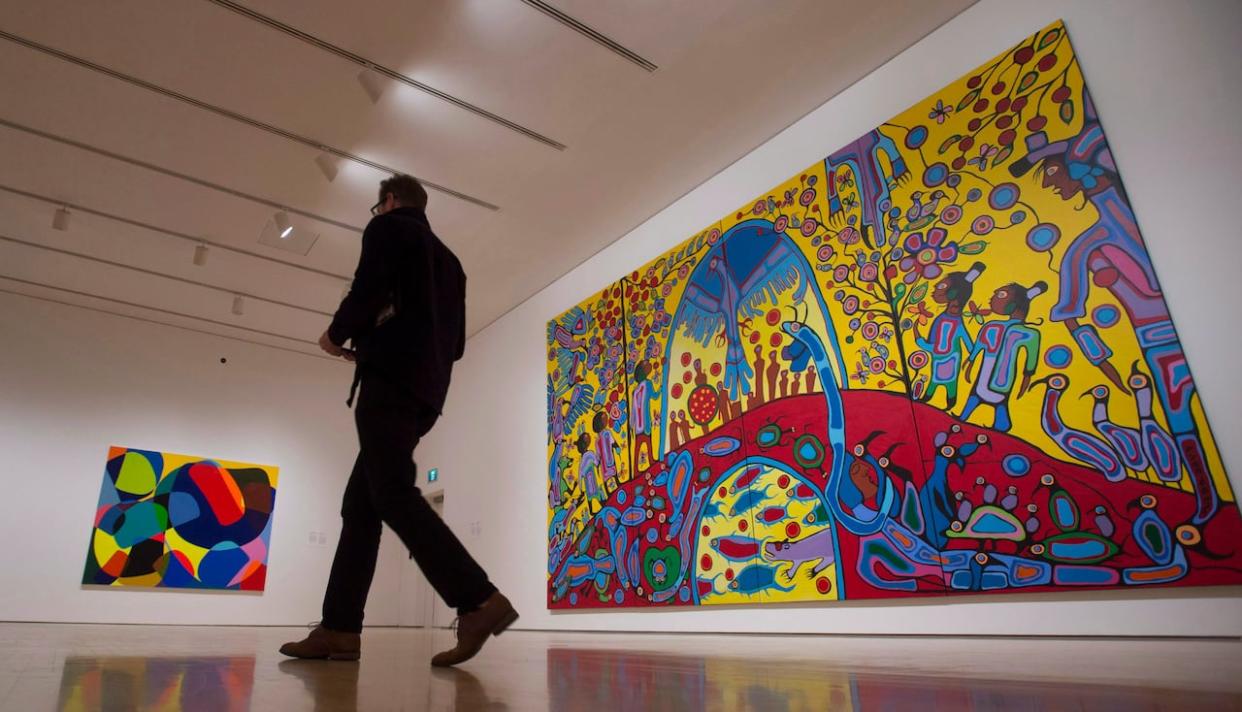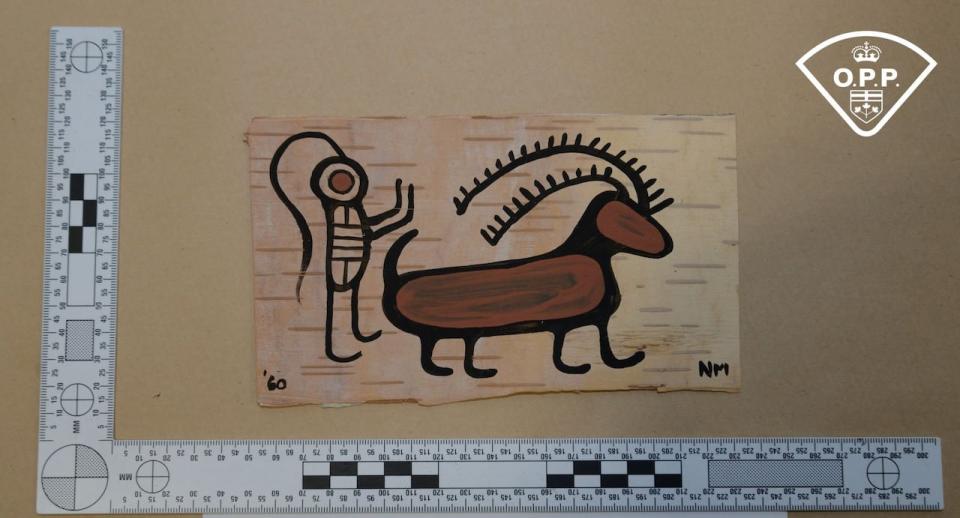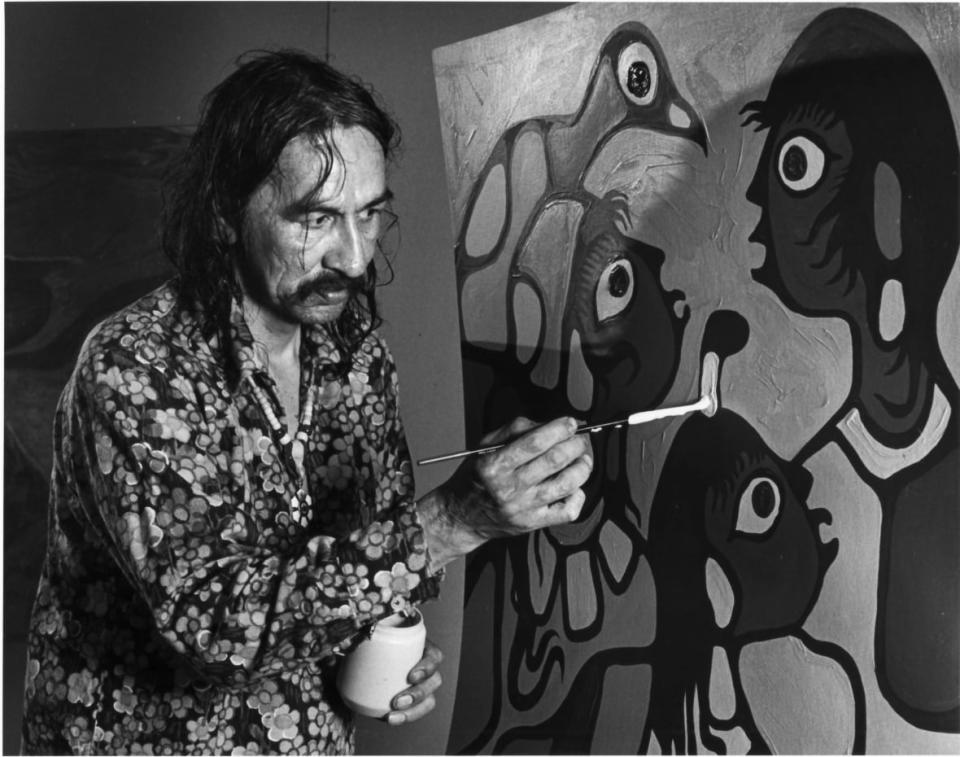Ringleader in Norval Morrisseau art fraud ring sentenced to 5 years on fraud charges

- Oops!Something went wrong.Please try again later.
One of eight people charged in what Ontario Provincial Police say is the largest art fraud investigation in Canadian history has been sentenced to five years incarceration, with credit for one year of time already served.
Gary Lamont pleaded guilty on Dec. 4 to a charge of making false documents, mainly artwork, that was attributed to the Anishinaabe artist Norval Morrisseau and a count of defrauding the public in an amount exceeding $5,000.
Lamont oversaw the production and distribution of hundreds of forged artworks falsely attributed to Morrisseau starting in 2002, according to the agreed statement of facts submitted to the courts.
According to the statement of facts, 190 "Lamont Ring Forgeries" have been identified to date, with 117 of them seized by investigators.
In handing down the sentence, the judge called the fraud an "appropriation of a cultural and spiritual identity of one of Canada's most loved and valued artists."
The court heard from victims, the Morrisseau estate and Lamont himself during a roughly four-hour sentencing hearing in Thunder Bay, Ont., Thursday.
"I'm very sorry and remorseful of what I've done and take full responsibility," Lamont said during his address to the court.
Prosecutors and defence lawyers agreed on the sentence of five years, with prosecutors noting that Lamont's guilty plea was a mitigating factor.
The aggravating factors included:
The extent of the fraud, which spanned 17 years.
The amount of paintings and victims involved.
The significant emotional and financial impact on the victims.
Lamont's previous criminal record, which includes sexual assault, drug charges and fraud.
Victims who came forward with impact statements said they felt betrayed and embarrassed by the fraud and had hoped to pass on the works they had purchased to loved ones.
A representative of the Norval Morrisseau estate said that the fraud had a devastating impact on the artist himself before his death in 2007, while he battled Parkinson's, and said it had also damaged relationships within the Morrisseau family.
Seven other people were charged as part of the ring, with five — Diane Marie Champagne, Benjamin Paul Morrisseau, Linda Joy Tkachyk and David John Voss — also scheduled to be in court Thursday.
Also charged are Jeffrey Gordon Cowan of Niagara-on-the-Lake, James (Jim) White of Essa Township and David P. Bremner of Locust Hill. They will be appearing in Barrie for pre-trial.

Police have charged eight people, including five from Thunder Bay, as a result of an investigation into fraudulent Norval Morrisseau artwork. Police seized more than 1,000 pieces, including this one, and say some of the pieces sold for tens of thousands of dollars to unsuspecting members of the public. (Ontario Provincial Police)
'Ugly criminality' connected to Morrisseau fraud
"To have one of the key figures that we've been interested in admit to his guilt in terms of creating fake Morrisseaus, that's a huge step forward," said Jonathan Sommer, a lawyer who specializes in art forgery.
Sommer represented Barenaked Ladies keyboardist Kevin Hearn in a lawsuit against a Toronto art dealer for allegedly selling him a fake Morrisseau painting. The Ontario Court of Appeal sided with Hearn and awarded him $60,000 in damages.
According to Sommer, it used to be very difficult to convince police and courts to take art fraud seriously.
"They treat it almost like an amusing spectacle, you know, a tale of charming rogues that defraud people who have more money than they know what to do with," he said.
"There's a lot of really ugly criminality that's connected with this art fraud."
Sommer estimates there are significantly more fraudulent works in circulation than genuine Morrisseau paintings, something he says has "severely muddied" the artist's legacy.
"They undermine the relationship between viewers of the art and who Morrisseau really was."

Norval Morrisseau as artist-in-residence in the Thomson Shack at the McMichael Gallery in Kleinberg, Ont., on July 11, 1979. (Ian Samson/McMichael Canadian Art Collection Archives)
'The real battle hasn't even started'
Police laid more than 40 charges against eight people in March after a years-long investigation into the forgery of the Morrisseau's work. The investigation led to the seizure of more than 1,000 pieces of forged Morrisseau art.
Cory Dingle, the executive director of the late artist's estate, says there are likely 5,000 more fraudulent Morrisseau paintings in circulation. "The real battle hasn't even started," he said.
Morrisseau's estate faces an expensive and fraught task — finding, investigating and denouncing the thousands of fake works to preserve Morrisseau's authentic legacy.
The sheer volume of fakes to identify combined with the difficulty of legally proving them to be inauthentic is an undue burden for the estate to bear, said Dingle.
"Canada really needs to have a federal arts-fraud division, because truly we are talking about our culture and our heritage that is being defrauded," he said.
Some other countries allow police to work with the estates of artists to identify and destroy fake paintings, said Dingle.
"That's how they clean up their market. Right now, Canada has no mechanism such as that."
LISTEN | What to do about fake Norval Morrisseau paintings:
A legacy diminished, but not destroyed
As the founder of Woodlands style art, Morrisseau's influence is so pervasive that the impact of the fraud reverberates throughout the Indigenous art scene, said art gallery owner Sophia Lebessis, who is Inuk.
"You're filled with rage and disappointment on a cultural level because it's like, here's another aspect of our lives that are just taken over and destroyed," said Lebessis, who owns Transformation Fine Art, a Calgary-based gallery of Inuit and First Nations art.
While fraudsters have damaged Morrisseau's legacy, Lebessis says they can't take away the positive impact his art has on the people who view it.
"What these criminals are not going to take away from us is that magical moment when you're walking into a gallery or you're walking into a museum and you're seeing a Morrisseau for your very first time," said Lebessis.
"That feeling that you felt, and all of a sudden your worldview changes, of Indigenous culture and Indigenous people. All of a sudden you're connected to this master artist who you might never have met."

